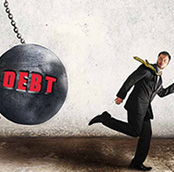An Overview of Consumer Bankruptcy Filings
Understanding Your Options When Filing for Personal Bankruptcy Protection
 You can do everything right when managing your finances and life can still happen. An unexpected injury or illness can leave you with extensive medical debt not covered by insurance. A pandemic can come along and cost you your job. A marriage can suddenly fall apart. But when life throws you a curve, bankruptcy laws are there to give you a fresh start.
You can do everything right when managing your finances and life can still happen. An unexpected injury or illness can leave you with extensive medical debt not covered by insurance. A pandemic can come along and cost you your job. A marriage can suddenly fall apart. But when life throws you a curve, bankruptcy laws are there to give you a fresh start.
What Is Bankruptcy?
Bankruptcy is a legal process, governed by federal and state law, in which a court helps you get control of your finances. There are different types of bankruptcy—some apply to consumers and others to businesses. The structure of these different types is set forth in the U.S. Bankruptcy Code, a federal law. With some bankruptcy types, the court orders assets to be sold to cover debts. Some assets, like a car, clothing, and household appliances, are typically exempt from court-ordered sale and can be kept by the consumer. Each state also has rules regarding property that can be protected.
One of the key benefits of filing for bankruptcy is the automatic stay, which goes into effect immediately upon filing and prevents your creditors from taking any action to collect a debt except through the bankruptcy process. The automatic stay means creditors can’t send you letters, e-mails, or text messages. In addition, they can’t call you on the phone or take any legal action against you that’s not in bankruptcy court.
The Different Types of Consumer Bankruptcy Filings: Chapter 7 vs. Chapter 13
A consumer or personal bankruptcy filing is filed under either Chapter 7 or Chapter 13 of the U.S. Bankruptcy Code. Chapter 7 bankruptcy is known as “liquidation” and generally requires the sale of the debtor’s assets. Chapter 13 bankruptcy is known as “reorganization” and involves the creation of a plan for the debtor to repay their debts while keeping all their property.
These are some key ways in which Chapter 7 bankruptcy differs from Chapter 13:
- You must qualify to file under Chapter 7 petition by submitting to a “means test” (discussed below)
- Chapter 7 allows you to permanently get rid of certain debt. With Chapter 13, you simply work out new payment arrangements for your debts.
- Chapter 7 is available to individuals or businesses. Businesses may not file under Chapter 13.
- A Chapter 7 bankruptcy can typically be completed in less than six months. A Chapter 13 proceeding will last until debts are paid off, typically three to five years.
- Chapter 13 lets you keep all your property. Under Chapter 7, you must relinquish all non-exempt assets to be sold by the bankruptcy trustee.
Chapter 7 Bankruptcy: Liquidation
A Chapter 7 petition, also known as a liquidation proceeding, allows a debtor to permanently discharge certain debts in exchange for relinquishing assets to the bankruptcy court. A debtor has no further legal obligation to pay any debts that are discharged. The assets given to the bankruptcy court are sold and the proceeds used to repay creditors.
Some debts, such as child support and alimony obligations, may not be discharged in a bankruptcy proceeding. Other obligations, such as student loan payments and most taxes, are extremely difficult to discharge.
A Chapter 7 filing does not affect liens on property. Accordingly, it’s used almost exclusively to discharge unsecured debt, such as medical bills, personal loans, or credit card debt. Someone who is behind on paying secured debts, like a mortgage or car note, may be better off using Chapter 13 (discussed below).
Under federal bankruptcy laws, a debtor may claim a certain amount of property as exempt from a Chapter 7 bankruptcy. A debtor may also choose to claim exemptions under state laws. However, exemptions cannot be mixed and matched. A debtor must either choose the exemptions available under federal law or the exemptions available under state law. A bankruptcy attorney can help you determine which exemptions are most beneficial to you.
In addition to clothing and household goods and appliances, the following property is typically exempt and can be kept by the debtor:
- A car, up to a certain value
- Jewelry, up to a certain value
- Some part of the equity in your house
- Tools required for your profession, up to a certain value
- Pension
- Damages received for a personal injury
The following property is typically not exempt and must be forfeited to the bankruptcy court:
- Collections of valuable art, coins, etc.
- A second vehicle
- A second home
- Valuable antiques or other family heirlooms
- Expensive musical instruments, unless the bankrupt party is a professional musician
What Are the Eligibility Requirements for Chapter 7 Bankruptcy?
To file for bankruptcy under Chapter 7, a debtor must submit to a means test. The means test looks at the amount of debt, the debtor’s essential expenses, and the debtor’s income and other financial resources in order to determine whether the debts can be paid off within a three-to-five-year period. A person is eligible to file under Chapter 7 only if the means test indicates that they would be unable to satisfy their debts within that time period. If you don’t pass the means test, your bankruptcy can be converted from Chapter 7 to Chapter 13.
You also must take a credit counseling course 180 days or less before filing. The bankruptcy court will not accept your filing without a certificate showing you completed the course.
How Does a Chapter 7 Bankruptcy Work?
If you qualify for protection under Chapter 7, you must prepare and submit an accurate and thorough accounting of all debts and assets to the bankruptcy court. You must then decide whether to take the available state or federal exemptions. Once you turn over all non-exempt property to the court, the court then discharges those debts that are eligible. The entire process usually takes four to six months, although it can go more quickly if the debtor has no assets to be liquidated.
After filing, you’re also required to take a debtor education course before your debts can be discharged. This course is in addition to the credit counseling course required before filing. The debtor education course focuses on how to make good financial decisions and avoid bankruptcy in the future.
What Is the Role of the Bankruptcy Trustee in a Chapter 7 Filing?
The trustee is an administrator appointed by the bankruptcy court to oversee a debtor’s estate throughout the bankruptcy proceedings. The trustee initially reviews the bankruptcy filing and all supporting documentation and then works with the debtor and their attorney to resolve any problems with the filing, collect all non-exempt assets, sell those assets, and allocate the proceeds to creditors.
Chapter 13 Bankruptcy: Reorganization
A Chapter 13 bankruptcy, also known as a “debtor’s reorganization,” is a legal process whereby a debtor can work out new payment arrangements with creditors while getting the protection of the automatic stay. Chapter 13 reorganization involves promises to repay creditors over a three-to-five-year period. The automatic stay remains in effect that entire period, provided the debtor honors his commitments. In the reorganization process, it’s not uncommon for a creditor to waive late fees or penalties already incurred or to accept less than the full amount of the debt, but such concessions are not required.
To be eligible for Chapter 13 bankruptcy, you must have a steady income and be current on your tax filings. In addition, you cannot have secured debt over $1,257,850 or unsecured debt of more than $419,275. (These figures are periodically adjusted.)
How Does Chapter 13 Bankruptcy Work?
When you file for protection under Chapter 13, the automatic stay goes into effect and creditors must stop all efforts to collect on your accounts. You must submit a thorough accounting of all debts, as well as all income and other financial resources. You must then submit a reorganization plan for the approval of both the court and your creditors. Creditors may file objections to your plan. There is typically a period of negotiation during which your plan might be altered.
Once a plan is approved by your creditors and the court, it goes into effect. The trustee receives your monthly payments and distributes them to creditors pursuant to the plan. A debtor in Chapter 13 typically does not deal directly with creditors. If you fail to meet your payment obligations under the plan, the court might dismiss your case.
What Are the Advantages and Disadvantages of Chapter 13?
The most compelling advantage of a Chapter 13 filing is that it allows you to keep all your property—there’s no requirement that you relinquish assets to the bankruptcy court. You’ll also get the benefit of the automatic stay for the entire repayment period established in your Chapter 13 proceeding, which is typically three to five years.
The primary disadvantage of filing a debtor’s reorganization is that you’ll remain legally responsible for paying your debts. Nothing is discharged, although you may be able to negotiate a reduced payoff. You must follow the approved plan to pay off your debts over time, or else your bankruptcy could be dismissed. While you’ll have the protection of the automatic stay for the entire period, a Chapter 13 proceeding typically takes much longer to complete than a Chapter 7 bankruptcy.
Summary
U.S. bankruptcy law was put in place to provide an opportunity for a fresh financial start. For consumers, the two options generally available are Chapter 7 and Chapter 13. A Chapter 7 petition lets you permanently rid yourself of certain debt in exchange for relinquishing unprotected assets to the bankruptcy trustee. You must, however, qualify to file under Chapter 7 by submitting to a “means test,” which determines if you have the resources to repay your creditors over a three-to-five-year period. If you don’t qualify under Chapter 7, you can reorganize your debt through a Chapter 13 filing, working out arrangements to repay your creditors over a three-to-five-year period. From the moment of filing, you have the protection of the automatic stay, which prohibits creditors from making any attempt to collect debts except through the bankruptcy process.
Related: Bankruptcy FAQs
Connect with Top-rated Attorneys Near You
Sponsored Advertisement
Other Bankruptcy and Debt Topics
Latest Article
What Is a Trust Fund? A Comprehensive Guide
A trust fund is a powerful tool that has stood the test of time. It is an essential instrument in modern wealth manageme... Read More
Arraignment: Meaning, Common Charges, & Process
Arraignment is a pivotal moment within the criminal justice system, marking the formal initiation of criminal proceeding... Read More
What Is Probable Cause? Definition and Examples
The Constitution protects you from being searched without a valid reason. But what exactly constitutes a valid reason? A... Read More
GETLEGAL®ATTORNEY DIRECTORY
Find Leading Attorneys in Your Area
NEED PROFESSIONAL HELP?
Talk to an Attorney
How It Works
- Briefly tell us about your case
- Provide your contact information
- Choose attorneys to contact you





